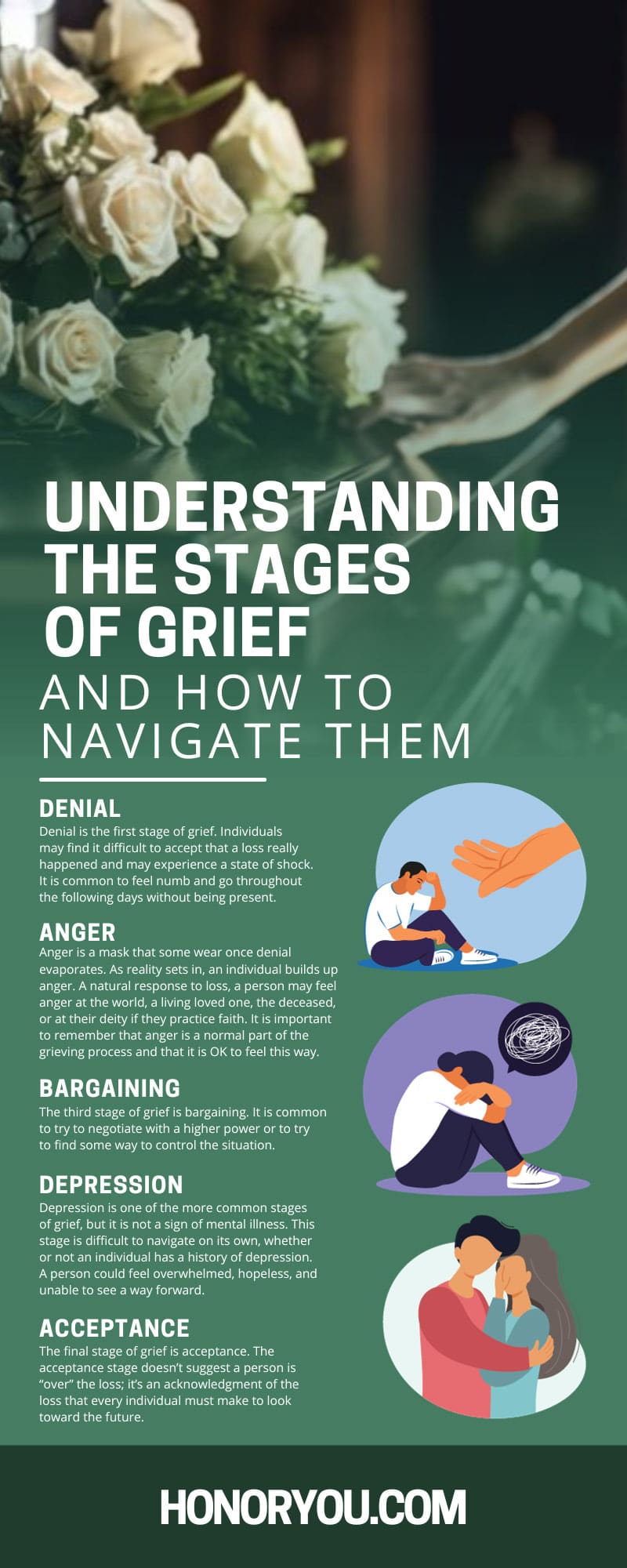Understanding the Stages of Grief and How To Navigate Them

Words of Comfort To Share at a Funeral Service
September 22, 2023
Tips To Make the Day of the Funeral Less Stressful
October 9, 2023Navigating the tumultuous waves of grief is no easy task. The journey is laden with confusion, anguish, and profound solitude, with each stage of grief ushering in its unique blend of emotions. It is not easy navigating the thick fog of grief. We understand and want to be an empathetic companion who supports you through your journey. Explore the stages of grief and how to navigate them so that you, your family, and your friends can better understand the characteristics of this universal experience. We encourage you to grieve at your own pace, and through this journey, we hope you find solace in knowing that you are understood and not alone.
The Stages of Grief
For some, the journey of grief comes in five stages, as proposed by Swiss psychiatrist Elisabeth Kübler-Ross. It’s essential to note that these stages are not linear, and not everyone will go through each of them or experience them in the prescribed order. Grief is a highly individual process that is unique to each person and each loss.
Denial
Denial is the first stage of grief. Individuals may find it difficult to accept that a loss really happened and may experience a state of shock. It is common to feel numb and go throughout the following days without being present.
When characterizing denial, the signs often include denying reality, feeling numb or disconnected, and going through the motions.
Some examples of denial include the following:
- Believing the deceased is “around the corner” or soon to return somehow
- Not making or accepting life-altering changes to reflect the loss
- Repeating the notion that this is a dream or something soon to pass
Anger
Anger is a mask that some wear once denial evaporates. As reality sets in, an individual builds up anger. A natural response to loss, a person may feel anger at the world, a living loved one, the deceased, or at their deity if they practice faith. It is important to remember that anger is a normal part of the grieving process and that it is OK to feel this way.
Some characteristics of anger include feeling irritable or easily frustrated, blaming others for your loss, and feeling robbed of a close connection. Any individual can experience anger during grief, no matter their relationship with the deceased.
Bargaining
The third stage of grief is bargaining. It is common to try to negotiate with a higher power or to try to find some way to control the situation.
Some characteristics of bargaining include wondering what you could have done differently to prevent the loss and trying to find a way to take control of the situation.
Those experiencing this form of grief may pray for the loved one’s return, offer to give up something important to them, or try to find someone to blame.
Depression
Depression is one of the more common stages of grief, but it is not a sign of mental illness. This stage is difficult to navigate on its own, whether or not an individual has a history of depression. A person could feel overwhelmed, hopeless, and unable to see a way forward.
Some characteristics of depression include feeling sad or hopeless, withdrawing from others, and losing interest in things the person used to enjoy.
Examples of depression include feeling as if you can’t get out of bed in the morning, believing there isn’t hope, and showing no interest in daily activities.
Acceptance
The final stage of grief is acceptance. The acceptance stage doesn’t suggest a person is “over” the loss; it’s an acknowledgment of the loss that every individual must make to look toward the future.
Some acceptance characteristics include feeling at peace with your loss, starting to plan for the future, and feeling grateful for your time with your loved one.
Acceptance includes talking about your loved one without feeling overwhelmed and emotional and finding joy in the world around you again.
Navigating the Stages of Grief
Navigating through these stages of grief is not a linear or predictable process. It is a unique journey for every individual, often characterized by swinging between separate phases rather than a steady progression. It’s crucial to allow oneself the freedom to move through these periods naturally, without haste or pressure to accept the irrevocable loss of someone close.
During this process, it’s essential to acknowledge and validate these emotions. The feelings of denial, anger, bargaining, depression, and acceptance are all part of the grieving process and are all normal. Individuals must allow themselves to feel these emotions in their entirety without judgment or suppression.
Seeking Support
Reaching out for help is a crucial aspect of navigating grief. This help can come from loved ones, including friends, family, or significant others. It can also come from professional sources such as grief and bereavement therapists or counselors. Support groups, both in-person and online, can also provide comfort and understanding between those undergoing the same process.
Remember, seeking help is not a sign of weakness. It’s a sign of strength and a healthy step toward healing. Don’t hesitate to seek help if grief feels like too much to handle, if your emotional state affects your physical health, or if you feel unable to move forward.
Self-Care During Grief
Self-care plays a pivotal role during the grieving process. Self-care activities can help you navigate your grief and understand your loss. Self-care actions can include maintaining a routine, eating healthy and exercising regularly, relaxing and unwinding, and sleeping adequately.
Get involved with your favorite activity, such as reading, listening to music, or going for a walk. Reconnecting with favorite hobbies and activities can provide a much-needed break from grief.
Writing can also be a powerful tool in dealing with grief. A journal can help you express your thoughts and feelings freely and privately. Sometimes, you can feel closer to a deceased loved one by writing letters to them—burn or store letters somewhere safe to help achieve comfort.
Grief is a personal journey with five commonly experienced stages: denial, anger, bargaining, depression, and acceptance. While it varies for each person based on coping style, experiences, and the nature of the loss, it’s essential to have a guide for understanding grief stages and navigating them. This guide is a pillar to help you embrace your emotions and learn to find support.
You can help keep the flame of your loved one’s memory glowing into eternity by getting personalized prayer cards from Honor You that help you remember and honor your loved ones. These keepsakes can be a comforting reminder whenever you miss them. Take the time you need to heal, and keep in mind that going through the stages of grief is normal. Remember—you’re not alone in this journey.



